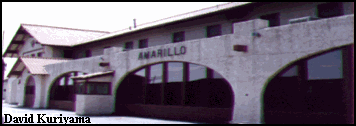
But as Chaplin reveals in his autobiography, a highly significant event in his life did occur in Texas, for it was in the Panhandle boomtown of Amarillo that he first discovered the extent of his fame.

In February of 1916, Chaplin was en route to New York on the Santa Fe Line to sign his contract with the Mutual Film corporation. Just as the train pulled into Amarillo, Chaplin heard his name being called, and soon discovered that an impromptu reception in his honor had been arranged on the platform of the Amarillo depot.
Unfortunately, only a handful of Panhandle newspapers from 1916 have been preserved, so no local report of this event survives, but with Chaplin's help we can at least set the scene. In MY AUTOBIOGRAPHY he recounts how he was mobbed for the first time:
"Hurriedly I washed my face and, half-shaved, put on a shirt and tie and came out of the train buttoning my coat."
"I was greeted with cheers. The mayor tried to speak...but his voice was drowned out by the continual cheering...Then the crowd pressed forward, pushing the mayor into me and squashing us against the train, so that for a moment the welcoming speech was forgotten in quest of personal safety."
Amarillo's population in 1916 was about 16,000-more than enough to supply the "large milling crowd" that Chaplin reports he saw on the platform, along with "bunting and flags...wrapped and hung from pillar to post" and "long tables set with refreshments"-sandwiches and Coca~Cola from the depot restaurant. In 1916, Amarillo had recently adopted a new municipal government and elected a wealthy businessman, J.N. Beasley, as its mayor. The Santa Fe Depot and Hotel, a handsome Southwestern stucco structure built in 1910-1912 for the considerable sum of $120,000 was a great source of local pride. Having learned from a telegram relayed through their telegraph office that Chaplin's train would be stopping there, the citizens of Amarillo evidently couldn't resist sharing their new civic amenities with someone they regarded as a celebrity. However, their spontaneous display of affection left Chaplin stunned: "when I returned to the train I sat meekly in my seat, my mind for the moment a blank...What had taken place in Amarillo I could not mentally digest or properly enjoy. I was too excited. I just sat tense, elated and depressed all at the same time."
As Chaplin would soon discover, his reception in Amarillo was only the beginning of a tidal wave of increasingly large crowds which would gather, in Kansas City, Chicago and New York, to greet him as he continued his trip.
Barely two years after his first film was released, Chaplin's renown had seemingly spread to every community in the country. His activities were newsworthy even in the small town of Plainview, Texas, about 65 south of Amarillo, where the report of his signing of the Mutual contract on February 26 appeared, a few weeks after his stop~over in Amarillo, in the Plainview Evening Herald of March 3: "Charles Chaplin, one of the most famous comedians the moving~picture industry has ever known, has recently formed a company for producing comedy. He has contracted with the Mutual people and will be making a feature at a later date in the Mutual programs. It is stated that to consummate the deal $1,500,000 was required."
Since Plainview's May I Theatre was a Mutual exhibitor, the author of this news item was obviously anticipating the arrival of the new Chaplin films in Plainview.

The old Santa Fe Depot still stands in Amarillo. Although rail passenger service there was discontinued years ago, the building is now used for dining and recreation. An attractively decorated restaurant offers a scenic view of passing trains, and by gazing out its arched windows at the narrow platform one can see how easily Chaplin and the mayor might have been crushed against the train by an unruly crowd. A number of historic railroad items are on display in the depot, but few, if any, people in Amarillo today are aware that its citizens once massed there, as Mayor Beasley proclaimed, to "show their appreciation for all the happiness" their famous guest had given them.